Instruction that Makes a Difference for Every Learner: Focus on the Use of Inclusive Instructional Practices - Part II
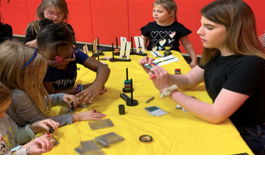
Grounded in Each Child, Our Future (Ohio’s Strategic Plan for Education: 2019-2024), a group of state and regional leaders supported by the Columbus-based University of Cincinnati Systems Development & Improvement Center, reorganized the work of Ohio’s regional support network (aka the statewide system of support or SSoS), around three key areas of practice: (1) inclusive instructional practices, (2) capacity building through professional capital, and (3) inclusive instructional and organizational leadership.
Deployment of evidence-based practices from these three inter-related areas (shown below) enables districts, community schools, and other education organizations to ensure that every child, regardless of characteristics or labels, is provided equitable opportunities to learn, strong core instruction, and the services and supports needed to achieve higher and deeper levels of learning.
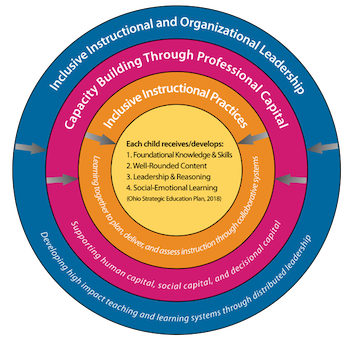
Part I of this two-part feature described the focus on using inclusive instructional practices and the necessary commitment to inclusivity as illustrated by two districts – Niles City Schools and Struthers City Schools – both of which are supported by State Support Team region 5.
Part II describes the structures used by both districts that help focus the work of collaborative learning teams and develop the inclusive instructional capacity of personnel at all levels of the system.
Structures that Support Shared Learning and System Improvement
Districts that are committed to providing equitable opportunities to learn for every child understand the necessity of preparing and supporting all teachers to use a variety of effective instructional practices and assess their impact on student learning. An isolated classroom-by-classroom or school-by-school approach is not sufficient. “From our perspective, building the collective capacity across all levels of the district system has to happen in order to address the needs of all learners. To that end, the SST focuses attention on supporting adults to proactively co-plan to meet the instructional needs of all learners through teacher-based teams or TBTs, through building leadership teams that monitor and support TBTs and, of course, through district leadership teams and district central office personnel who oversee the successful implementation of effective practices in all schools in the district,” explained Michele Moore, SST Region 5 Director. SST 5, which is operated through the Mahoning County Educational Service Center in Canfield, serves districts, community schools, and other education organizations in Mahoning, Trumbull, Ashtabula, and Columbiana counties.
The OLAC-OIP connection.
Developed in 2007 by the Ohio Department of Education and refined in 2018-2019, the Ohio Improvement Process (OIP) is used by a majority of Ohio school districts and community schools as their primary improvement model. From its inception, the OIP was meant to be used as a mechanism for enacting essential leadership practices as defined by the Ohio Leadership Advisory Council (OLAC) in order to support system-wide improvement in instructional practice on behalf of all learners. Rather than focus on leadership as a title or role with positional authority, OLAC-OIP framed leadership as essential practices that must be implemented, regardless of role, across the system.
This intentional connection between OIP as a continuous improvement process (the “how”) and OLAC leadership practices (the “what”) was operationalized through the use of a coordinated set of collaborative learning teams at the district (district leadership team or DLT), school (building leadership team or BLT) and classroom (teacher-based team or TBT) level.
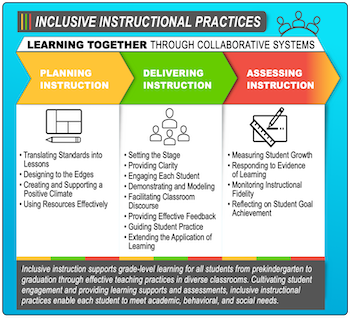
“The collaborative team structures of the OIP process are important. When we talk about a teacher leader, or a member of the team, or a principal, or a director of school improvement, or even if I’m at the meeting, we all have an equal voice. So, it doesn’t matter what your role is. When I speak, I’m speaking with the equality of a first-year teacher speaking. And that’s important to get that across in our team meetings that we’re all focused on instructional improvement. Your position or your title doesn’t matter when you speak at our OIP meetings,” explained Pete Pirone, Superintendent of the Struthers City School District.
Transforming central office to serve a support, rather than compliance function, has been shown to be a critical factor in helping schools improve the quality of teaching and learning (Honig, et al., 2010).
The OIP was designed to be applicable to all districts and to support districts – regardless of improvement status – to foster a district-wide culture of inquiry and continuous improvement in instructional practice and student learning. As such, it also provides a common framework for all regional providers (e.g., state support team personnel) to use in supporting districts in their regions. Learning together through collaborative systems – DLTs, BLTs, and TBTs working together – is the foundation for the effective use of inclusive instructional practices across the system.
“The conversations in our teacher-based teams, building leadership teams, and in our district leadership team are focused on looking at data and then making decisions based on the data we see. Team structures support rich conversations that are truly embedded in what is best for children,” said Niles City Schools superintendent Ann Marie Thigpen. “The fidelity of implementation of inclusive instructional practices in literacy, especially at our primary and intermediate level, is close to 100% because of the use of team structures. Our regular classroom teachers, Title I teachers, and intervention specialists are working collaboratively to support student learning,” she added.
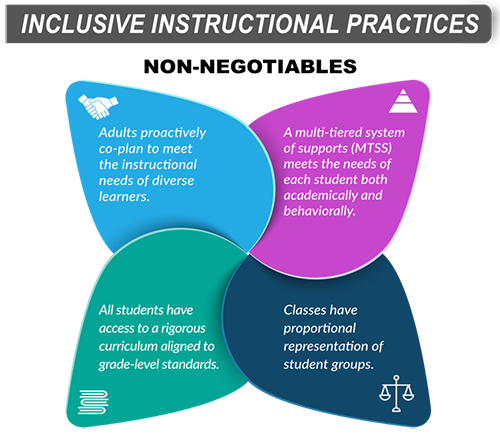
Non-negotiables.
Adults working collaboratively to support student learning, as described by Thigpen, is at the heart of inclusive instructional practice. “Adults need to work together, whether we’re talking about our English Learners, our students with disabilities, or any other group of students, in order to meet the instructional needs of diverse learners in the general education setting to the maximum extent possible where they’re exposed to strong core instruction,” said Moore.
Ensuring that all students have access to rigorous curriculum aligned to grade-level standards, using a multi-tiered system of supports to provide each learner with equitable access to strong core instruction plus additional needed supports, and attending to the proportional representation of students with learning challenges so that they are not segregated are non-negotiables underlying the effective use of inclusive instructional practices.

“Coming into the district five years ago as an administrator in Struthers, that collaborative planning time was already built into the schedule and teachers actually craved the time to be able to work together,” said Bethany Carlson, Administrator (aka Principal) of Struthers Elementary School. “Our goal is to better meet students’ needs through collaboration using the OIP. It’s not about compliance; it’s about doing what is best for kids,” she added.
“That collaborative piece, that team planning, is essential for the success of all of our students. Our mindset is not ‘we’ll have to do the TBT, or BLT, or DLT.’ It’s the collaborative piece that allows all staff to plan together to prepare lessons for all students and it’s that collaborative effort that administrators model to the teachers, and then teachers model to the students. Creating that open and collaborative atmosphere for our staff has now become second nature,” reflected Pirone.
The involvement of administrators in both the Struthers and Niles City school districts is viewed as a support, rather than a compliance activity. “When we have professional development, all of our administrators actively attend. You’re not leaving to go to the office to solve a problem during team time,” explained Pirone.

“I feel as an administrator, I have to share the responsibility for effective use of our TBTs with the teachers. It’s important that the administrator be in those meetings to work as part of the team and focus the work on finding the right strategy or intervention, implementing it, honing the skill, and then coming back in two weeks to look at the results,” offered Chris Staph, Principal of Niles Intermediate School. “Teachers need to know that you’re there, you’re seeing it, you’re a part of the team,” concurred Allyson Martin, Assistant Principal of Niles Middle School.
The power of harnessing the collective perspectives and areas of expertise of adults to meet student needs cannot be overstated. Amanda McNinch, Coordinator of Special Services for Struthers City Schools, recalls one TBT meeting that was facilitated by the intervention specialist. “The high school principal called to tell me that one of my intervention specialists took over the TBT meeting and talked about how a particular strategy that he had used in more restrictive settings could be used to support not only students eligible for special education, but all students who weren’t succeeding on a particular assignment. The TBT structure and that planned meeting time provided an audience for the intervention specialist to share how teachers could address the instructional needs of more students. We’re talking about teaching!”
OIP Team Structures – Content Knowledge Synergy: Greater than the Sum of Its Parts
The Niles City and Struthers City school districts have used OIP team structures (i.e., DLT, BLTs, TBTs) to build instructional capacity, particularly in the area of literacy. In turn, gaining a deeper understanding of evidence-based literacy strategies through involvement in the state’s literacy initiatives (Niles as an early literacy pilot district and Struthers as a member of the Mahoning County Striving Readers Consortium) has led to more effective use of OIP team structures.

“Struthers has gone further beyond what’s in the Striving Readers grant to embrace some of the other literacy initiatives that the state supports, like Heggerty training,” said Moore. Carlson explains: “Through the support that SST 5 provided through the Literacy Academy and other offerings, such as PD related to Anita Archer’s explicit instruction and the Simple View of Reading, we’ve taken the tools, the materials, and what we’re learning about effective practices and embedded them district-wide through our team structures. Pretty much all of our grants have a foundation based on what we’ve learned from the State Support Team.”
Focusing team discourse. In Niles, OIP teams evolved over the past five years from what Superintendent Ann Marie Thigpen called “fragmented and non-functional” to teams that are focused on instruction and learning together. “Because of the support from SST 5 and the work we’ve done through the early literacy pilot, all of our conversations have included a focus on what we’re working on with regard to literacy at each one of our buildings. The members of our district leadership team, which include the high school and the middle school principals, have been a part of and are embedded in that conversation,” said Thigpen. “Even at our principals meetings, which are different than our district leadership team meetings, the conversation is focused on improving literacy in all buildings,” she added.
The combination of having an instructional focus (e.g., literacy) and the use of collaborative team structures has also changed the nature of the conversation that teams in Struthers are having.

“For years, we had administrative meetings and would go through a two-hour meeting only to find out that we didn’t spend more than a few minutes on instruction. One of the things I did as a superintendent was to schedule two administrative meetings a month; the first meeting of the month would involve discussion on academics only. Our standing agenda would include discussion around our inclusive practices in each building, how our DLT, BLTs, and TBTs are doing, the walk throughs our principals are doing, the kind of PD teachers need, etc. I do not allow that meeting to get off focus from academics, which is very difficult to do because there are so many other things to attend to like grounds, cafeterias, athletics, and bussing. It’s being intentional as a superintendent and sticking to a focus on academics and instructional practices,” explained Pirone.
"We could not support teacher learning without collaborative team structures."
Christopher Staph
Principal, Niles Intermediate School
Administrative team meetings in Struthers are separate from the District Leadership Team, and involve the superintendent, six building administrators (two from each school), the director of special services, and a part-time director of school improvement. “Everything we do, we do collaboratively and make sure our professional development follows our mission, vision, and OIP focused plans. So, even though administrators are in three different buildings, we work together and with central office to support each other. We don’t work in isolation; instead, we’re guided by what’s best for our district,” said Carlson.
“We’ve had worthwhile conversations in our TBTs about different literacy strategies, specifically in the area of writing when the middle school BLT decided that strategies needed to be implemented across grade levels. The growth we’ve seen, especially with our struggling learners because we took the time to learn a literacy skill and strategy and writing prompt that could be maintained, is just remarkable. We have students with significant cognitive disabilities who are now able to write a paragraph where that expectation in the resource room may not have been met,” offered Amanda McNinch, Coordinator of Special Services for Struthers City Schools.
Like Struthers, Niles’ use of OIP structures has been instrumental in developing a common vocabulary and approach to instruction. “Being on the same page, being united and collaborating from our district level to our buildings, and to the classroom supports adult implementation and builds teacher efficacy,” said Allyson Martin, Assistant Principal of Niles Middle School. “We could not support teacher learning without collaborative team structures,” added Chris Staph, Principal of Niles Intermediate School.
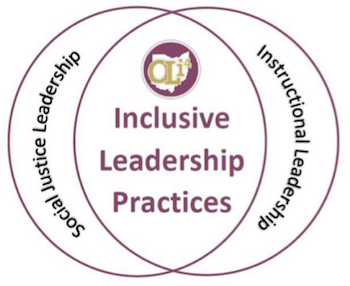
Sharing leadership.
“The power is in the team and using effective OIP team structures doesn’t happen without support from effective leaders who take intentional steps to meet the needs of each learner in their school district,” stated Moore. District leadership in both the Niles and Struthers school districts recognize the importance of sharing leadership in order to support teacher learning across the district. “Our goal has been leadership and literacy,” said Thigpen.
Both districts have supported the development of leadership capacity – Niles through involvement in the Ohio Leadership for Inclusion, Implementation, and Instructional Improvement (OLi4) and Struthers through involvement with SST 5 professional learning using OLi4 concepts and tools.
OLi4 supports cohorts of principals and district representatives in supporting teacher learning and in the effective use of OIP team structures by addressing six key practice domains: (1) visioning, (2) using data well, (3) sharing leadership, (4) reflecting on practice, (5) coaching teaching, and (6) using research and evidence to guide instruction. OLi4 is unique in its combined emphasis on social justice and instructional leadership and is aligned with the state’s focus on the use of inclusive instructional and organizational leadership.
High-quality instructional materials and online learning resources developed by and accessible at no cost through OLAC are used to support OLi4 cohort member learning. Cohort members participate over a two-year period in centralized professional learning, regional cadre discussion groups focused on applying lessons learned in relation to common problems of practice, and in-school one-on-one coaching on a monthly basis. During the 2019-2020 school year, approximately 60 principals participating as Cohort 5 are completing their second year of the program, and 130 principals (i.e., Cohort 6) are engaged in their first year of OLi4 professional learning.
“At the district leadership team, we have addressed one of our goals in our three-year plan to be leadership and our administrative team participates in OLi4,” said Thigpen. Pirone agrees that engaging all adults in using effective leadership practices to support instructional improvement for every learner is essential. “It’s the collaborative effort that the administrators model to the teachers, and then the teachers model to the students,” said Pirone.
For more information about shared learning, the collaborative process, and more, go to the Ohio Leadership Advisory Council at www.ohioleadership.org and click on Educator Resources and then click on OLAC Modules.
Watch for the spring and summer 2020 issues of Cornerstone Connections for a focus on capacity building through professional capital, and inclusive instructional and organizational leadership!
References
Baker, S.K., Fien, F., Nelson, N. J., Petscher, Y., Sayko, S., & Turtura, J. (2017). Learning to read: “The simple view of reading”. Washington, DC: U.S. Department of Education, Office of Elementary and Secondary Education, Office of Special Education Programs, National Center on Improving Literacy. Retrieved from http://improvingliteracy.org
Honig, M. I., Copland, M. A., Lorton, J. A., Rainey, L. R., & Newton, M. (2010). Central office transformation for districtwide teaching and learning improvement: A report to the Wallace Foundation. Seattle: The Center for Teaching and Policy, University of Washington.
Ohio Department of Education. (2019). Each child, our future. Ohio’s strategic plan for education (2019-2024). Columbus, OH: Author. Retrievable from http://education.ohio.gov/getattachment/About/Ohios-Strategic-Plan-for-Education/Final-Strategic-Plan-Board-Approved.pdf.aspx?lang=en-US.
Ohio Department of Education. (2018). Ohio’s plan to raise literacy achievement: Birth through grade 12. Columbus, OH: Author. Retrievable from http://education.ohio.gov/getattachment/Topics/Learning-in-Ohio/Literacy/Ohios-Plan-to-Raise-Literacy-Achievement.pdf.aspx?lang=en-US.
For More Information
For more information about SST 5 and how regional personnel support districts, contact Michele Moore, Director, SST 5, at 330.533.8755 or via email at michele.moore@sstr5.org.
For more information about Struthers City School District, contact Superintendent Pete Pirone at 330.750.1061 or via email at pete.pirone@strutherscityschools.org.
For more information about Niles City School District, contact Superintendent Ann Marie Thigpen at 330.989.5095 or via email at annmarie.thigpen@nilesmckinley.org.
For more information about Ohio’s literacy initiatives, contact Dr. Melissa M. Weber-Mayrer, Director, Office of Approaches to Teaching and Professional Learning, Ohio Department of Education, at 614.728.8095 or via email at Melissa.Weber-Mayrer@education.ohio.gov.
For more information about OLi4, contact Dr. Pamela VanHorn, project coordinator, UC Systems Development & Improvement Center, at 614.897.0020 or via email at: vanhorpm@ucmail.uc.edu.
For more information about the OLAC and OIP resources, contact Dr. Jim Gay, OLAC Co-director, at jimgay@basa-ohio.org; or Karel Oxley, OLAC Co-director, at Oxley@basa-ohio.org.